Riley Bailey
Ukrainian light infantry has advanced to positions beyond anti-tank ditches and dragon’s teeth anti-tank obstacles that comprise the current Russian defensive layer ahead of the Ukrainian advance in western Zaporizhia Oblast, and Ukrainian forces likely intend to hold those positions. ISW is not prepared to assess that Ukrainian forces have breached this Russian defensive layer in the absence of observed Ukrainian heavy equipment in these areas. Geolocated footage published on September 4 indicates that Ukrainian forces advanced to tree-line positions that are east of the Russian anti-tank ditches and dragon’s teeth obstacles that are a part of a tri-layered defense immediately west of Verbove (18km southeast of Orikhiv).[1] Geolocated footage published on September 4 indicates that Ukrainian light infantry has also advanced further into a series of prepared Russian defensive positions along the road that runs northwest into Verbove.[2] Other geolocated footage published on September 4 indicates that Ukrainian forces have advanced up to Russian defensive positions between Robotyne (10km south of Orikhiv) and Novoprokopivka (13km south of Orikhiv).[3] Ukrainian forces are widening the breach they have already made in one Russian defensive layer and are reportedly maneuvering more equipment and personnel into tactical rear areas of this layer.[4] Ukrainian forces appear to be making gains in the immediate vicinity of the not-yet-breached Russian defensive layer that runs northwest of Verbove to north of Solodka Balka (20km south of Orikhiv) with infantry assaults and heavy artillery fire on Russian positions further into and south of this layer.[5] The deployment of Ukrainian heavy equipment and more substantial forces to these areas than ISW has so far observed would indicate both a breach of this Russian defensive layer and an effort to widen that breach.
Russian forces reportedly attempted to expand minefields in southern Ukraine following the start of the Ukrainian counteroffensive in June. The Royal United Services Institute (RUSI) reported that the Russian command determined at the start of the Ukrainian counteroffensive that Ukrainian forces might be able to easily breach the Russian doctrinal minefield depth of 120 meters leading Russian forces to aim to increase the depth of their minefields up to 500 meters.[6] RUSI stated that Russian forces lacked enough mines to mine these larger areas as densely as Russian doctrine dictates, causing Russian forces to deviate from doctrine, including by using improvised explosive devices and a wider and differential distance between mines.[7] RUSI stated that Russian forces tried to compensate for decreased minefield density by increasing the effectiveness of anti-tank mines by placing two on top of each other.[8] Ukrainian operations across several sectors of the front have likely further compounded these constraints on the Russian effort to expand minefields by forcing Russian forces to disperse their mining efforts along wide sectors of the frontline. Ukrainian Tavriisk Group of Forces Spokesperson Oleksandr Shtupun stated on September 3 that minefields near the next series of Russian defensive positions in western Zaporizhia are less dense than the initial defensive layer that Ukrainian forces advanced through.[9] ISW has previously assessed that Ukrainian forces may encounter denser minefields at certain sections of subsequent series of Russian defensive positions, however.[10]
Limitations on Russian artillery capabilities and Ukrainian advantages in counter-battery fire are forcing the Russians to deviate from their own doctrine, RUSI reported. RUSI stated that Russian forces have been attempting to adapt their fire doctrine since before Ukrainian counteroffensive operations began.[11] RUSI noted that Russian forces are attempting to prioritize strike accuracy over volume because they lack enough ammunition to sustain doctrinally designated artillery fire, have difficulties transporting a large volume of ammunition to frontline areas, and are seeing diminishing effectiveness of mass strikes as they lose counterbattery radars and their guns suffer from barrel wear.[12] RUSI stated that Russian forces are attempting to increase the production of Krasnopol laser-guided shells and the use of Lancet drones (loitering munitions) in order to increase accuracy and reduce the number of munitions used in attacks.[13] RUSI also observed that Russian forces have often prepared their fighting positions for remote demolition with improvised explosives instead of striking their own positions with artillery after Russian forces have withdrawn, as Russian doctrine dictates.[14] These adaptations suggest that reduced Russian artillery capabilities may be further weakening the Russian defense in certain sectors as artillery fire is a critical component of the Russian elastic defense. A shift towards more precise fire doctrine may allow Russian forces to strengthen these capabilities, but constraints on Russian training capacity will likely prevent Russian forces from implementing this shift at scale in the near term. Russian sources have continually claimed since the start of the counteroffensive that the Russians lack sufficient counterbattery capabilities on various sectors of the front.[15] Estonian Defense Forces Intelligence Center Commander Colonel Margo Grosberg reported on September 1 that Ukrainian artillery capabilities are “equal or even better” than those of Russian forces and have been able to push Russian artillery units back from the frontline, preventing them from supporting Russian forces.[16]
Russian forces conducted a drone strike on Dnipropetrovsk and Odesa oblasts on the night of September 3-4. The Ukrainian Air Force reported that Russian forces launched 32 Shahed 136/131 drones from Cape Chauda, Crimea, and Primorske-Akhtarsk, Krasnodar Krai on the night of September 4 and that Ukrainian air defenses shot down 23 of the drones.[17] Ukrainian Southern Command Spokesperson Captain First Rank Nataliya Humenyuk stated that Russian drones struck civilian infrastructure in Odesa Oblast, and Russian sources claimed that drones struck port infrastructure in Reni and Izmail, Odesa Oblast.[18] Head of Dnipropetrovsk Oblast Council Mykola Lukashuk reported that a drone strike destroyed 1,500 tons of grain in Dnipropetrovsk Oblast.[19] Ukrainian Foreign Ministry Spokesperson Oleg Nikolenko stated that a Russian drone fell on Romanian territory, which the Romanian Ministry of Defense subsequently denied.[20]
Russian President Vladimir Putin reiterated Russia’s unwillingness to rejoin the Black Sea Grain Initiative until all of Russia’s extensive terms are met at a meeting with Turkish President Recep Tayyip Erdogan. Putin reiterated claims that the West ignored its obligations to allow Russia to export grain and fertilizer at a meeting with Erdogan in Sochi, Russia on September 4.[21] Putin claimed that Russia will supply 25,000 to 50,000 tons of grain for free to unspecified African countries in “the coming days.”[22] Putin and Erdogan claimed that Turkey is willing to help process and transport one million tons of grain intended for these countries.[23] Putin and Erdogan also announced Qatar’s interest in providing financial support so that these countries can receive free grain.[24]
Head of the UN Independent International Commission of Inquiry on Ukraine Erik Mose stated on September 4 that the commission has not yet concluded that Russia is committing genocide in Ukraine. Mose stated that the commission must determine the intent of the perpetrators and identify the “need” to physically or biologically exterminate a certain group to meet the legal qualifications under the Genocide Convention.[25] Mose stated that the commission has found evidence for a large number of war crimes, specifically evidence of torture and strikes on Ukrainian energy infrastructure that the commission could consider as crimes against humanity.[26] Mose also stated that the commission previously determined that certain statements in Russian mass media could be considered as incitement to commit genocide.[27] Mose noted that the commission’s investigation into genocide in Ukraine will continue.[28] Article II of the 1948 Convention of the Prevention and Punishment of the Crime of Genocide (the Genocide Convention) states that “genocide means any of the following acts committed with intent to destroy, in whole or in part, a national, ethnical, racial, or religious group, as such: killing members of the group; causing serious bodily or mental harm to members of the group; deliberately inflicting on the group conditions of life calculated to bring about its physical destruction in whole or in part; imposing measure intended to prevent births within the group; forcibly transferring children of the group to another group.”[29] Article III states that “the following acts shall be punishable: genocide; conspiracy to commit genocide; direct and public incitement to commit genocide; attempt to commit genocide; complicity in genocide.”[30]
Key Takeaways:
- Ukrainian light infantry has advanced to positions beyond anti-tank ditches and dragon’s teeth anti-tank obstacles that comprise the current Russian defensive layer ahead of the Ukrainian advance in western Zaporizhia Oblast, and Ukrainian forces likely intend to hold those positions. ISW is not prepared to assess that Ukrainian forces have breached this Russian defensive layer in the absence of observed Ukrainian heavy equipment in these areas.
- Russian forces reportedly attempted to expand minefields in southern Ukraine following the start of the Ukrainian counteroffensive in June.
- Limitations on Russian artillery capabilities and Ukrainian advantages in counter-battery fire are forcing the Russians to deviate from their own doctrine, RUSI reported.
- Russian forces conducted a drone strike on Dnipropetrovsk and Odesa oblasts on the night of September 3-4.
- Russian President Vladimir Putin reiterated Russia’s unwillingness to rejoin the Black Sea Grain Initiative until all of Russia’s extensive terms are met at a meeting with Turkish President Recep Tayyip Erdogan.
- Head of the UN Independent International Commission of Inquiry on Ukraine Erik Mose stated on September 4 that the commission has not yet concluded that Russia is committing genocide in Ukraine.
- Russian forces conducted offensive operations along the Kupyansk-Svatove-Kreminna line, near Bakhmut, along the Avdiivka-Donetsk City line, in the western Donetsk-eastern Zaporizhia Oblast border area, and in western Zaporizhia Oblast and advanced in some areas on September 4.
- Ukrainian forces conducted offensive operations and advanced near Bakhmut and in western Zaporizhia Oblast on September 4.
- Russian Defense Minister Sergei Shoigu announced on September 4 that the Russian military will not be holding “Zapad-2023” joint strategic exercises scheduled for September.
- Russian occupation officials continued the fifth day of early voting for Russian regional elections in occupied territories on September 4.
- Russian Main Effort – Eastern Ukraine (comprised of two subordinate main efforts)
- Russian Subordinate Main Effort #1 – Capture the remainder of Luhansk Oblast and push westward into eastern Kharkiv Oblast and encircle northern Donetsk Oblast
- Russian Subordinate Main Effort #2 – Capture the entirety of Donetsk Oblast
- Russian Supporting Effort – Southern Axis
- Russian Mobilization and Force Generation Efforts
- Activities in Russian-occupied areas
Russian Main Effort – Eastern Ukraine
Russian Subordinate Main Effort #1 – Luhansk Oblast (Russian objective: Capture the remainder of Luhansk Oblast and push westward into eastern Kharkiv Oblast and northern Donetsk Oblast)
Russian forces continued offensive operations along the Kupyansk-Svatove-Kreminna line on September 4 but did not make any confirmed advances. The Ukrainian General Staff and Ukrainian Deputy Defense Minister Hanna Malyar reported that Russian forces conducted unsuccessful offensive operations near Novoyehorivka (16km southwest of Svatove) and Bilohorivka (12km south of Kreminna).[31] Ukrainian Eastern Group of Forces Spokesperson Ilya Yevlash stated that Russian forces have begun to strengthen their positions near Novoyehorivka and have stopped storming Ukrainian positions in the area.[32] Russian sources claimed that Russian forces attacked near Novoyehorivka and east of Petropavlivka (7km east of Kupyansk).[33] A prominent Russian milblogger claimed that the tactical situation near Synkivka (9km northeast of Kupyansk) and Petropavlivka was stable, however.[34] A Russian news aggregator claimed that Russian forces took control of an unspecified number of Ukrainian positions and advanced 2km in the Kupyansk direction, although ISW has not observed visual confirmation of this claim.[35] Malyar stated that Ukrainian forces repel several Russian attacks per day in the Kupyansk direction.[36]
Russian sources claimed that Ukrainian forces continued ground attacks along the Svatove-Kreminna line on September 4 but did not advance. The Russian Ministry of Defense (MoD) claimed that elements of the Russian Western Grouping of Forces repelled four Ukrainian assaults north of Tverdokhlibove (17km southwest of Svatove).[37] Russian milbloggers claimed that Ukrainian forces conducted three unsuccessful assaults on Russian positions near the Serebryanske forest area south of Kreminna.[38]
Russian Subordinate Main Effort #2 – Donetsk Oblast (Russian objective: Capture the entirety of Donetsk Oblast, the claimed territory of Russia’s proxies in Donbas)
Ukrainian forces conducted offensive operations near Bakhmut and advanced on September 4. Geolocated footage published on September 4 indicates that Ukrainian forces advanced east of Orikhovo-Vasylivka (11km northwest of Bakhmut).[39] Ukrainian Deputy Defense Minister Hanna Malyar stated that Ukrainian forces achieved unspecified successes near Klishchiivka (7km southwest of Bakhmut) and that Ukrainian forces have liberated three square kilometers in the Bakhmut direction in the past week.[40] Ukrainian Eastern Group of Forces Spokesperson Ilya Yevlash stated that Ukrainian forces continue offensive operations in the Bakhmut direction, particularly near Klishchiivka.[41] The Russian MoD claimed that Ukrainian forces unsuccessfully attacked near Bakhmut.[42] A Russian milblogger claimed that Ukrainian forces attacked near Kurdyumivka (13km southwest of Bakhmut) and in Klishchiivka.[43] Russian sources claimed that there are positional battles near the Berkhivka reservoir northwest of Bakhmut.[44] A Russian milblogger claimed on September 3 that Ukrainian forces advanced near Andriivka (10km southwest of Bakhmut) in the past week.[45]
Russian forces conducted offensive operations near Bakhmut but did not make any confirmed gains on September 4. The Ukrainian General Staff and Malyar reported that Russian forces unsuccessfully attacked north of Klishchiivka and near Kurdyumivka and Ozaryanivka (14km southwest of Bakhmut).[46] A Russian news aggregator claimed that Russian sources regained unspecified lost positions near Kurdyumivka.[47] A Russian milblogger claimed on September 3 that Russian forces achieved unspecified successes near Klishchiivka and pushed Ukrainian forces back from Berkhivka (6km northwest of Bakhmut) in the past week.[48]
The Russian MoD claimed that Ukrainian forces conducted unsuccessful offensive operations along the Avdiivka-Donetsk City line near Sieverne (6km west of Avdiivka) on September 4.[49]
Russian forces conducted offensive operations along the Avdiivka-Donetsk City line and reportedly advanced on September 4. The Ukrainian General Staff and Malyar stated that Russian forces conducted unsuccessful offensive actions near Sieverne, Avdiivka, Marinka (on the western outskirts of Donetsk City), Krasnohorivka (directly west of Donetsk City), and Novomykhailivka (10km southwest of Donetsk City).[50] Select Russian sources claimed on September 3 and 4 that Russian forces successfully attacked near Novomykhailivka and Krasnohorivka, whereas a Russian milblogger claimed on September 4 that Russian forces unsuccessfully attacked near these settlements and near Sieverne.[51] A Russian news aggregator claimed on September 3 that Russian forces attacked near Krasnohorivka, but did not specify an outcome.[52] A Russian milblogger claimed on September 3 that Russian forces attacked western Marinka and south of Avdiivka in the past week.[53]
Russian Supporting Effort – Southern Axis (Russian objective: Maintain frontline positions and secure rear areas against Ukrainian strikes)
Russian sources claimed that Ukrainian forces conducted offensive operations in the western Donetsk-eastern Zaporizhia Oblast border area on September 4 but did not advance. A Russian milblogger claimed that Ukrainian forces conducted unsuccessful offensive operations near Pryyutne (15 km southwest of Velyka Novosilka).[54] The milblogger also claimed that Ukrainian forces pushed Russian forces from heights near Rivnopil (10km southwest of Velyka Novosilka) along the Pryyutne-Starmlynivka-Kermenchyk (15km southwest to 15km southeast of Velyka Novosilka) line in the past week.[55]
Russian forces conducted offensive operations in the western Donetsk-eastern Zaporizhia Oblast border area on September 4 but did not make confirmed or claimed gains. The Ukrainian General Staff reported that Russian forces conducted unsuccessful offensive operations near Pryyutne.[56] Footage shot on September 2 and published on September 4 purportedly shows elements of the 218th Tank Regiment (127th Motorized Rifle Division, 5th Combined Arms Army, Eastern Military District) striking Ukrainian positions near Staromayorske (9km south of Velyka Novosilka).[57] Footage published on September 4 purportedly shows elements of the 36th Motorized Rifle Brigade (29th Combined Arms Army, Eastern Military District) operating near Mykilske (just southeast of Vuhledar).[58]
Ukrainian forces conducted offensive operations in western Zaporizhia Oblast on September 4 and made tactically significant advances. Geolocated footage published on September 4 shows that Ukrainian forces advanced south of Robotyne (9km south of Orikhiv) and west of Verbove (18km southeast of Orikhiv).[59] Ukrainian Deputy Defense Minister Hanna Malyar reported that Ukrainian forces continue offensive operations in the Melitopol direction (western Zaporizhia Oblast) and achieved unspecified successes in the direction of Novodanylivka (5km south of Orikhiv) and Novoprokopivka (13km south of Orikhiv).[60] Russian milbloggers claimed that Ukrainian forces advanced in contested areas east of Novoprokopivka in the direction of Ocheretuvate (25km southeast of Orikhiv).[61] A Russian milblogger claimed that Ukranian forces continue to advance near Robotyne and Verbove, while the Russian MoD and other Russian sources claimed that these attacks were unsuccessful.[62] Several Russian sources continued to claim that the southern part of Robotyne is contested and that Russian forces maintain defensive positions on the southern outskirts of the settlement.[63] A Russian source claimed that Ukrainian forces attacked near Dorozhnyanka (34km southeast of Orikhiv).[64]
Geolocated footage published on August 26 indicates that Ukrainian forces are operating further south of Kamianske (30km southwest of Orikhiv) than previously observed, suggesting that Russian forces exert less control over the surrounding area.[65]
The Russian MoD claimed that Russian forces “improved their tactical situation” near Robotyne and Verbove on September 4, although ISW has not observed evidence or claims of recent Russian advances in the area.[66] Geolocated footage published on September 4 shows elements of the “Osman” Spetsnaz formation operating near Verbove.[67] Footage published on September 4 purportedly shows elements of the “Pryzrak” (Ghost) Company of the 291st Motorized Rifle Regiment (42nd Motorized Rifle Division, 58th Combined Arms Army, Southern Military District) operating along the Kopani-Nesteryanka line (10-12km southwest of Orikhiv) and elements of the 5th Company of the 429th Motorized Rifle Regiment (19th Motorized Rifle Division, 58th Combined Arms Army, Southern Military District) operating near Zherebyanky (26km southwest of Orikhiv).[68]
The Russian MoD claimed on September 4 that Russian forces destroyed four Ukrainian boats with landing groups moving toward Cape Tarkhankut in occupied Crimea.[69] A Kremlin-affiliated milblogger claimed that Russian forces destroyed four Ukrainian boats and that one Ukrainian boat returned to Ukrainian-held territory.[70]
Russian Mobilization and Force Generation Efforts (Russian objective: Expand combat power without conducting general mobilization)
Russian Defense Minister Sergei Shoigu announced on September 4 that the Russian military will not be holding “Zapad-2023” joint strategic exercises initially scheduled for September.[71] Shoigu notably stated that Russian forces have “exercises” in Ukraine, likely acknowledging that the Russian military lacks the equipment and personnel needed for such exercises due to the war in Ukraine.[72] Ukrainian intelligence previously reported in Winter 2023 that Russia and Belarus were planning to conduct major joint strategic exercises “Zapad-2023“ and ”Union Shield-2023" with Belarusian forces and that Russian forces would deploy to Belarus for these exercises.[73]
Russian President Vladimir Putin signed a law increasing the age limit for conscription deferments for Russian IT specialists from 27 to 30.[74] This increase in the deferment age corresponds with a recent law that will increase the upper limit of the conscription age range from 27 to 30 for those eligible for conscription starting in the Spring of 2024 conscription cycle.[75] The deferments for IT specialists likely aim to minimize the human capital impacts of the war in Ukraine while also preventing further “brain drain” from Russia.
Russian officials appear to be pursuing joint exercises with North Korea. Shoigu stated on September 4 that Russian officials are discussing the possibility of conducting joint exercises with North Korea.[76] South Korea’s National Intelligence Service Head Kim Kyou-hyun reportedly told the South Korean National Assembly on September 4 that in July Shoigu proposed to North Korean leader Kim Jong Un that Russia, China, and North Korea hold a joint naval exercise.[77]
Activities in Russian-occupied areas (Russian objective: Consolidate administrative control of annexed areas; forcibly integrate Ukrainian citizens into Russian sociocultural, economic, military, and governance systems)
Russian occupation officials continued early voting for Russian regional elections in occupied territories on September 4.[78] The Ukrainian Resistance Center stated on September 4 that Russian authorities so far are allegedly recording a 38 percent voter turnout in occupied Kherson Oblast, a 39 percent turnout in occupied Donetsk Oblast, and an 18 percent turnout in Zaporizhia and Donetsk oblasts.[79] Ukrainian Luhansk Oblast Head Artem Lysohor published an alleged Russian occupation document on September 4 showing that Russian officials recorded 1.3 million residents being eligible to vote in occupied Luhansk Oblast.[80] Lysohor noted that many of the figures for eligible voters in occupied settlements clearly do not account for widespread depopulation since the start of the full-scale invasion and Russian occupation.[81] Russian occupation officials will likely record inflated participation in the regional elections in an attempt to portray them as legitimate.
Russian occupation officials continue to expand organs aimed at social control in occupied Ukraine. Donetsk People’s Republic (DNR) Head Denis Pushilin announced on September 4 that the occupied Donetsk Oblast regional channel of the All-Russian State TV and Radio Broadcasting Company began broadcasting.[82] Pushilin added that ultranationalist milblogger Andrei Rudenko will lead the news channel.[83] Kherson Oblast occupation commissioner for children's rights Natalya Tishchenko met with Russian Commissioner for Children’s Rights Maria Lvova-Belova on September 4 to announce the opening of the Kherson Oblast headquarters of the Russian Children’s Rights Commission's humanitarian mission “In the Hands of Children.”[84]
Significant activity in Belarus (Russian efforts to increase its military presence in Belarus and further integrate Belarus into Russian-favorable frameworks and Wagner Group activity in Belarus)
The Russian-dominated Collective Security Treaty Organization (CSTO) continued the “Combat Brotherhood-2023” operational-strategic command staff exercises in Belarus on September 4.[85]
Belarusian Deputy Minister of Internal Affairs and Commander of the Internal Troops Major General Nikolai Karpenkov reportedly thanked a group of Wagner instructors for training Belarusian Spetsnaz forces at a ceremony in Belarus. A Russian source claiming to be affiliated with the Wagner Group claimed on September 3 that Karpenkov addressed a group of Wagner instructors and thanked them for training Belarusian Spetsnaz forces and for displaying “professionalism, dedication, and brotherly attitude.”[86]
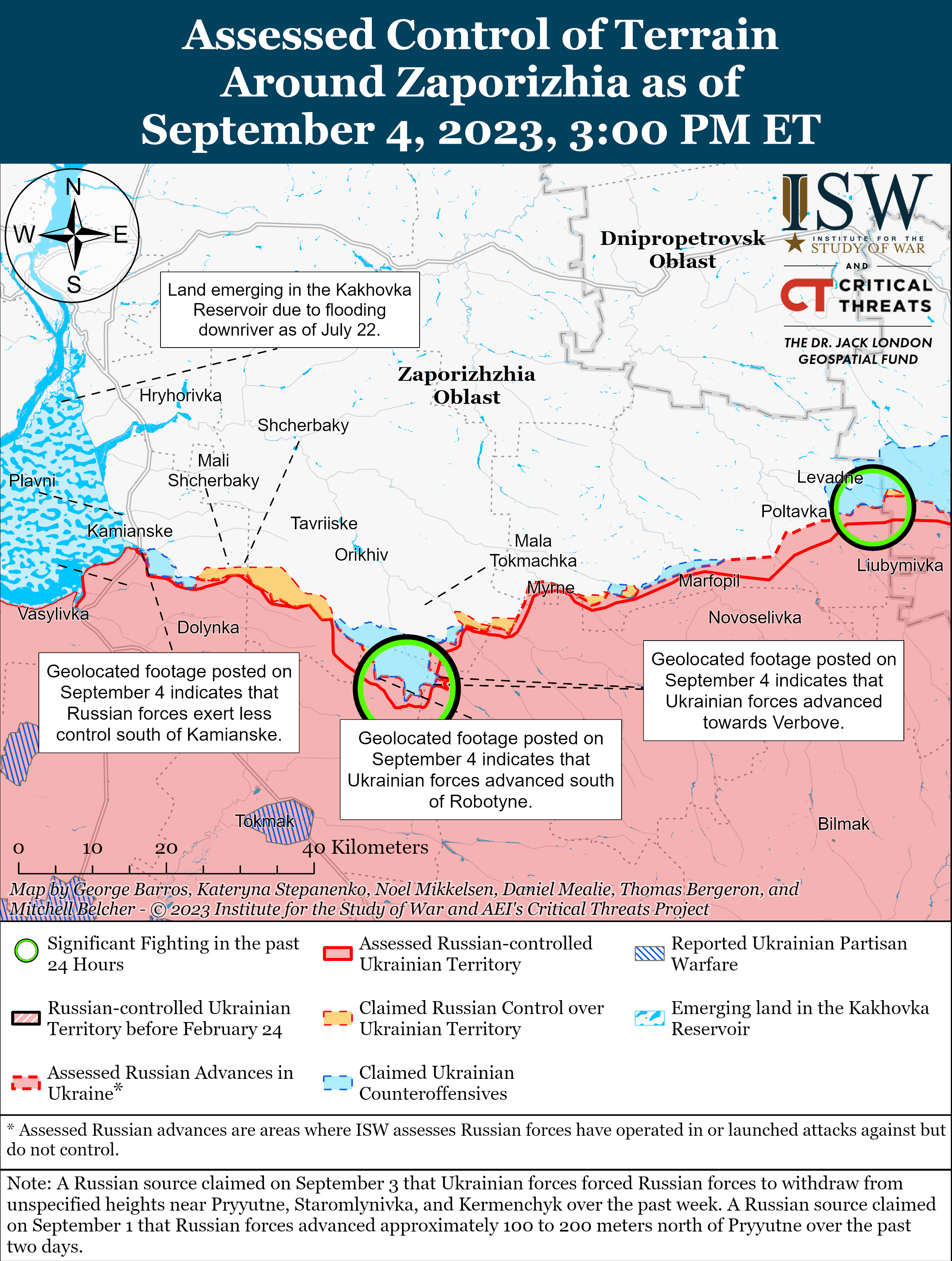
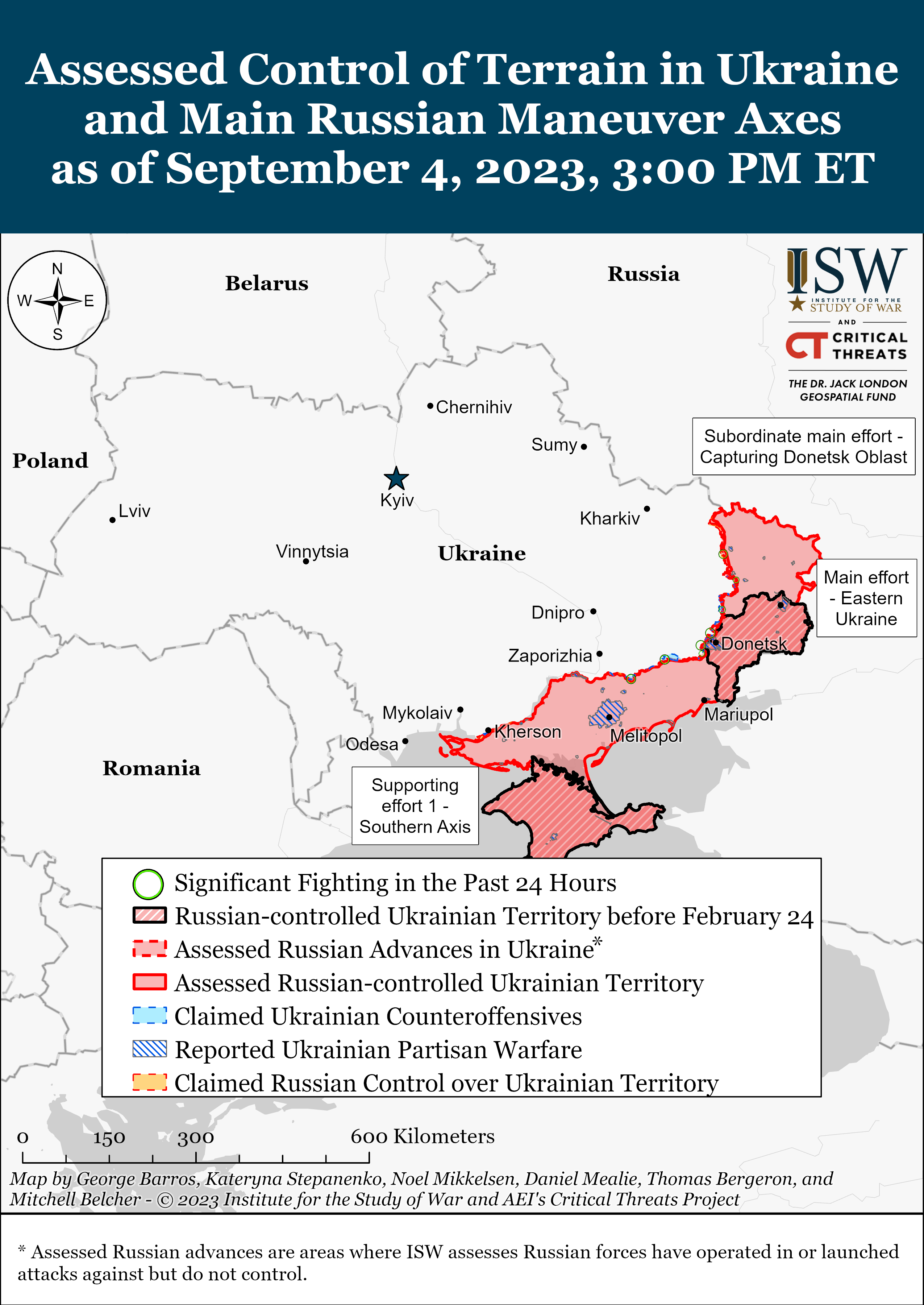
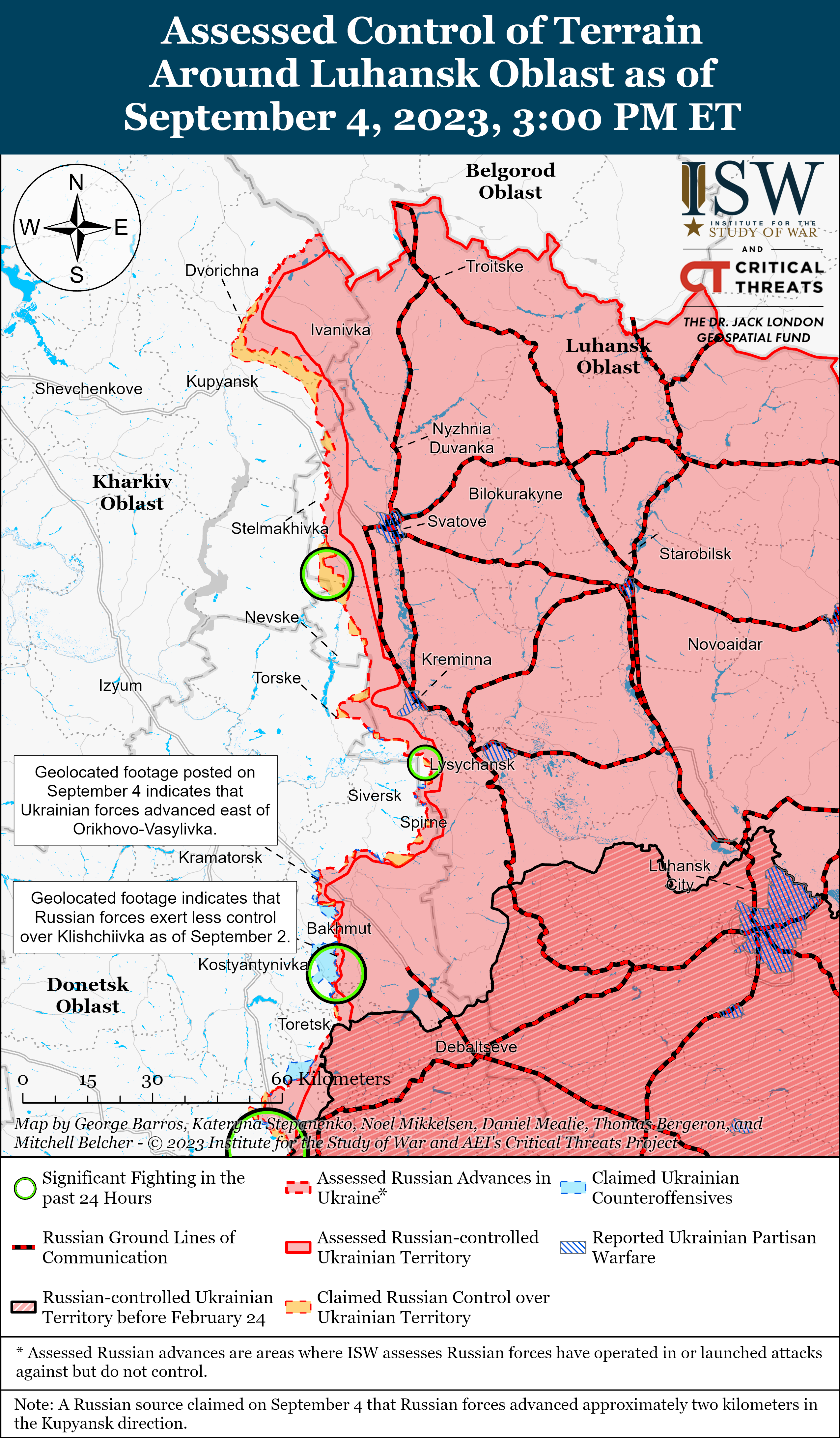
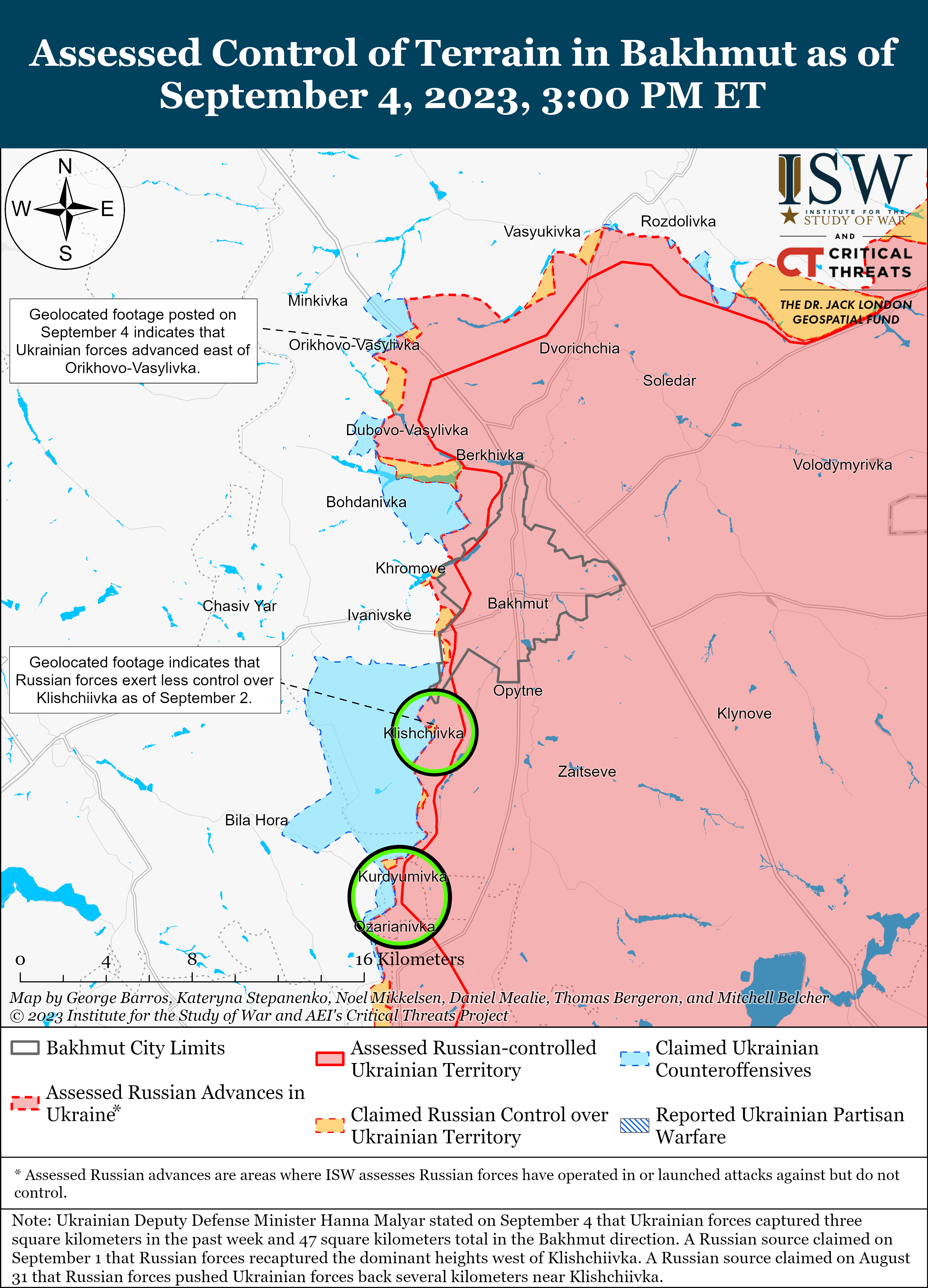
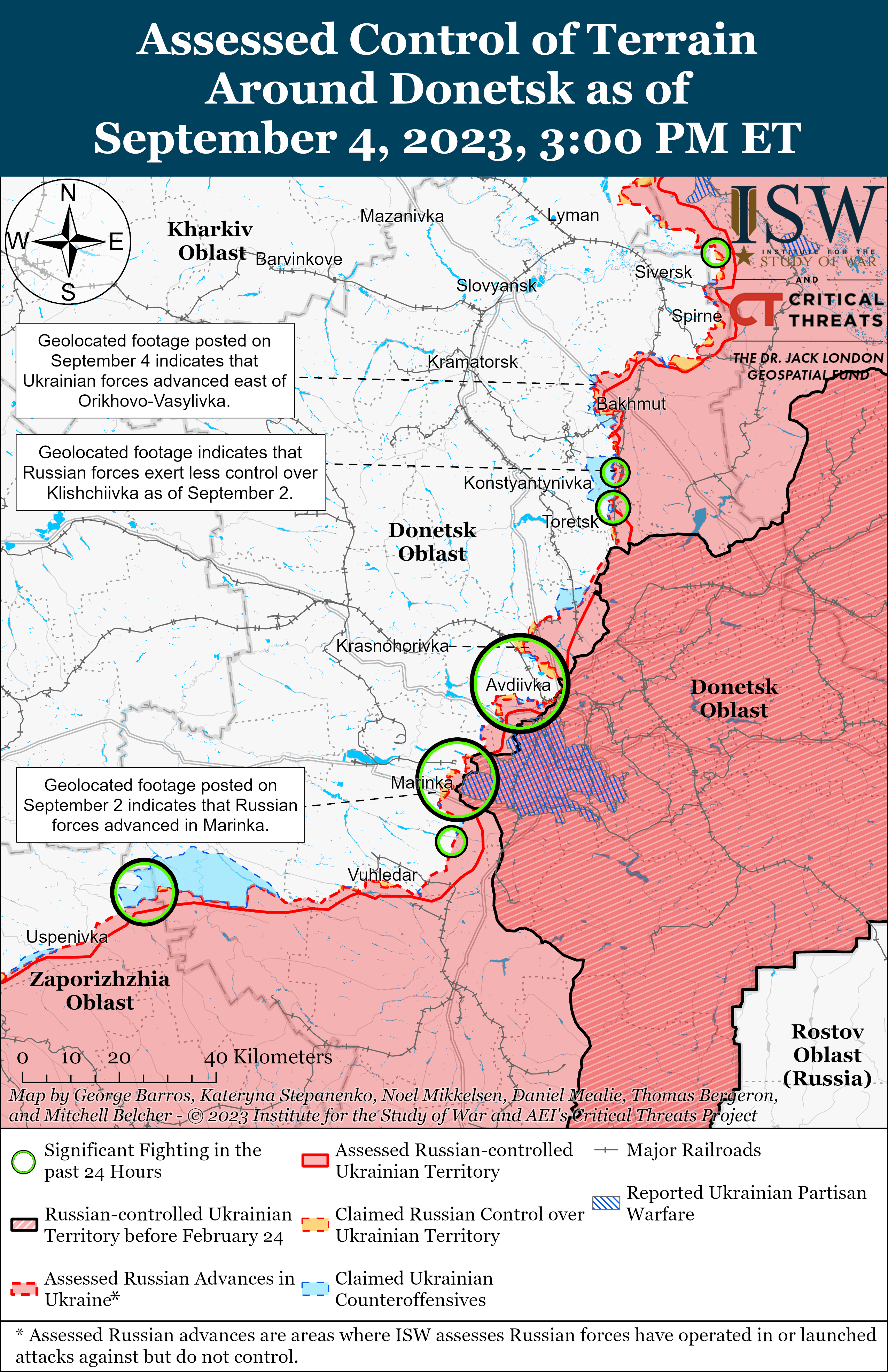
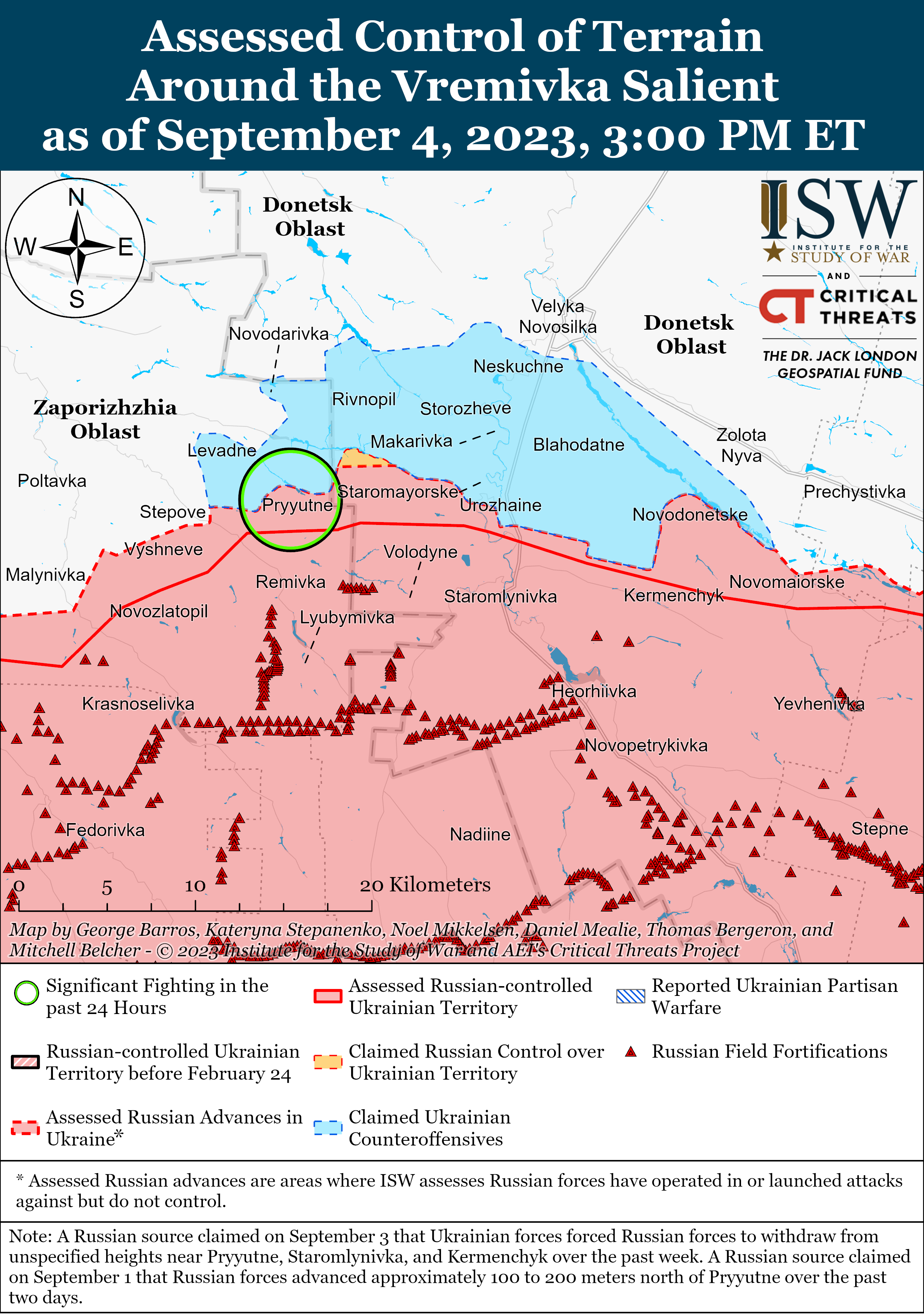
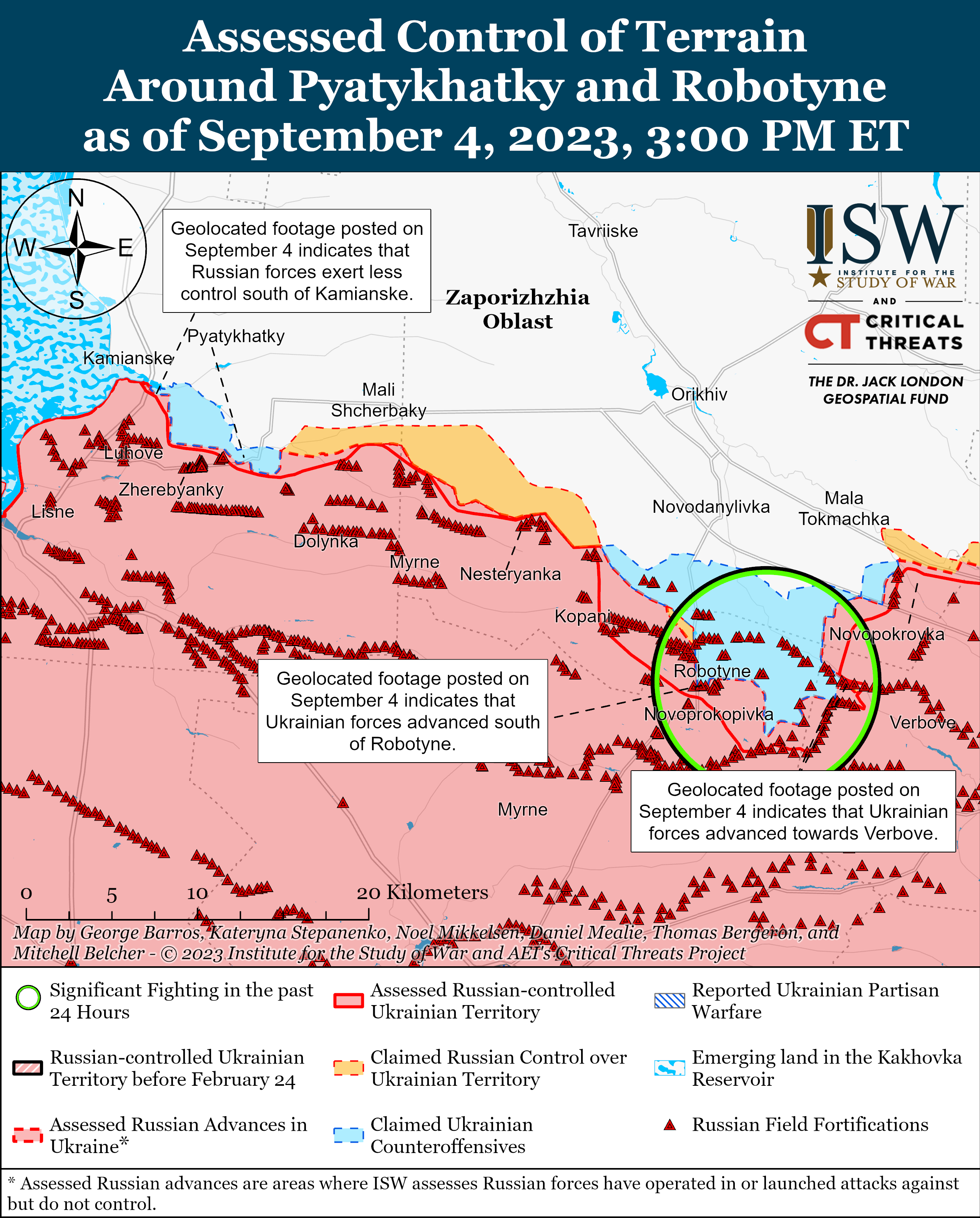
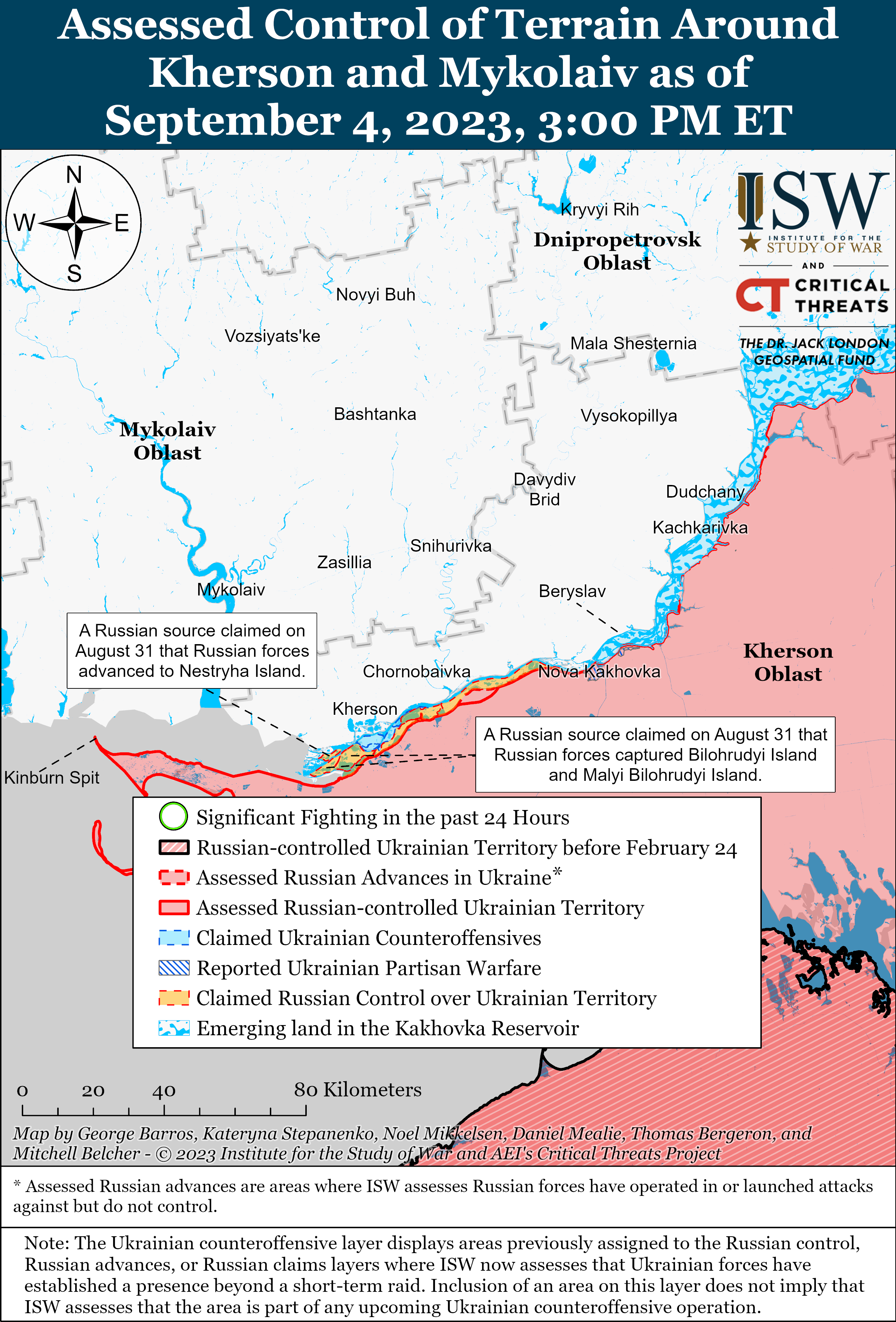
No comments:
Post a Comment